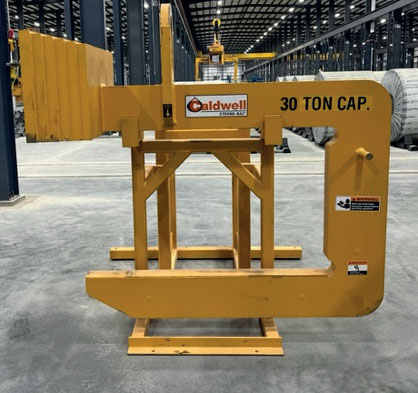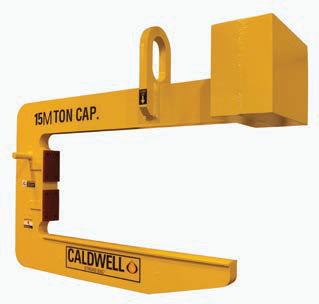Below the hook: C-hooks
22 December 2023Even when a requirement for a C-hook has been identified, there are many different options and types for consideration, writes Bill Gridley, application sales, The Caldwell Group Inc.
AC-hook is an overhead lifting device used to pick up rounds with an inner diameter, but there’s more to them than many people realise.
They are most commonly used for handling steel coils, which are found in multiple industries, such as automotive, stamping, metals processing and service centres. Each of these sectors present some of the most demanding material handling applications, so while C-hooks might not be overly complicated at first glance, they are more nuanced than they look.
Such hooks come in a variety of sizes and capacities, ranging from 100lbs up to 60 tons. As such, the price users pay to add C-hooks to their fleets ranges widely from four figures to five.
A high-end manufacturer, like Caldwell, might customise up to 60% of the C-hooks it sells, due to varying coil dimensions, and the environments where they are used presenting space or headroom limitations. Requests for protective padding on the face or back of the hook are also not uncommon.
As each C-hook can be unique, the material used is based upon the working load limit required for the application. Smaller and lighter duty hooks can be manufactured from A36 steel whereas T1 steel is used for larger, heavier duty products. The calculations and material selected are based on the length and height of the lifting arm.
Thus, there are a number of important considerations to make before choosing a C-hook:
- Outer diameter: Often called the OD, this is the measurement of the outside edges of the load (coil, pipe, etc.) passing through the centre.
- Inner diameter: Often called the ID, this is the measurement of the distance of a straight line from one point on the inner wall of the load through its centre, to an opposite point, still on the inside. ID is, therefore, dependent on the OD and wall thickness.
- Other dimensions: It is also important to know the height and width of the load.
- Weight: Whether by documentation provided with known weights or measured by load monitoring device, knowing the weight of the load is, of course, of vital importance.
- Lifting capacity: Once the data above is available, it is necessary to source the appropriate type, size and capacity of C-hook. It will likely be utilised beneath an overhead crane or hoist, which must also be factored into planning.
- Stacking: Because of the nature of the work in environments where rounds with an inner diameter are prevalent, there is nearly always a need to stack them, either for storage or prior to transportation to another facility.
When each of these items (and often more) have been addressed, the purchasing decision maker can begin sourcing the right C-hook. These calculations might see them arrive at a point where they need a twosided lifter instead, which is not covered in this article. Here, we look at some of the more common types of C-hooks.
- Narrow coil: Used for smaller width coils; they are usually a smaller capacity as well. They handle narrow coils with less coil edge damage and are often used as a more durable alternative to webslings. They are lightweight and often feature a guide handle for ergonomic benefits.
- Dixon hook: Featuring a pivoting wedge, they are completely different from a standard C-hook and allow the operator to convert a coil from horizontal to vertical. Because of the nature of this material handling application, limited sizes are typically available.
- Close stacking: Again, this is a product manufactured with stacking of coils in mind. Featuring a recessed counterweight for closer stacking, these hooks are commonly found at steel service centres where floorspace is at a premium. When stacking coils together the user must consider the need for a more compact material handling design.
- Slit coil: These longer-arm C-hooks lift multiple slit coils (steel slitting is a manufacturing process where a coil of steel is slit into specified lengths and widths) to maximise handling efficiency. Where present, a recessed counterweight minimises interference with equipment and other obstacles.
Standard features throughout often include high-tensile alloy steel plate to reduce size and weight, while many C-hooks are counter-balanced to hang level when empty. Heavy-duty can be a misleading term in below-the-hook manufacturing; in fact, all Caldwell products, for example, are heavy-duty.
Mill-duty C-hooks, meanwhile, are for extreme use, usually where high duty cycles and high temperatures are present. Users should perform pre-use inspections before applying attachments or overhead lifters at the point of use. Typical C-hook use wear items include the lifting bail, although there is not much more that can go wrong unless a product is misused.

